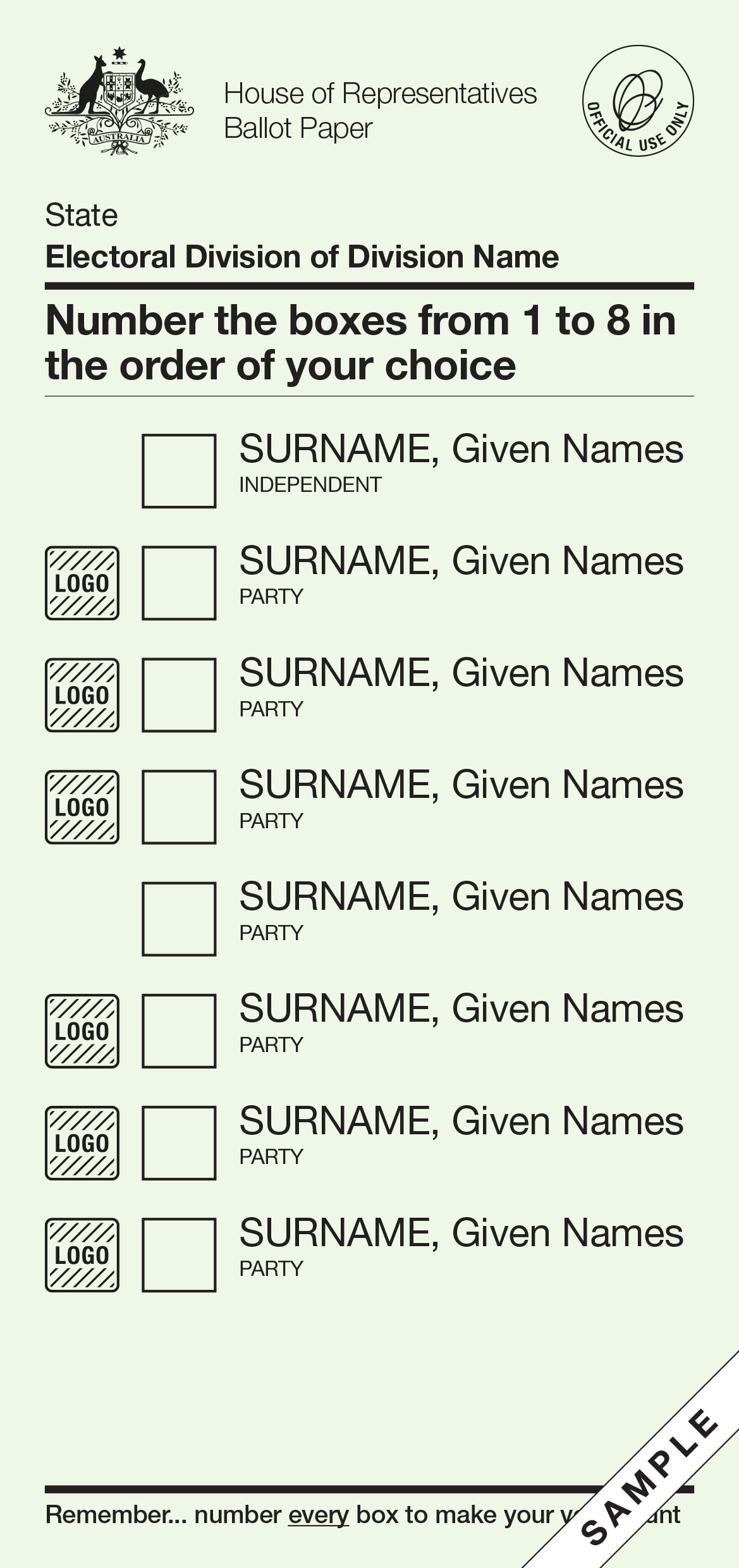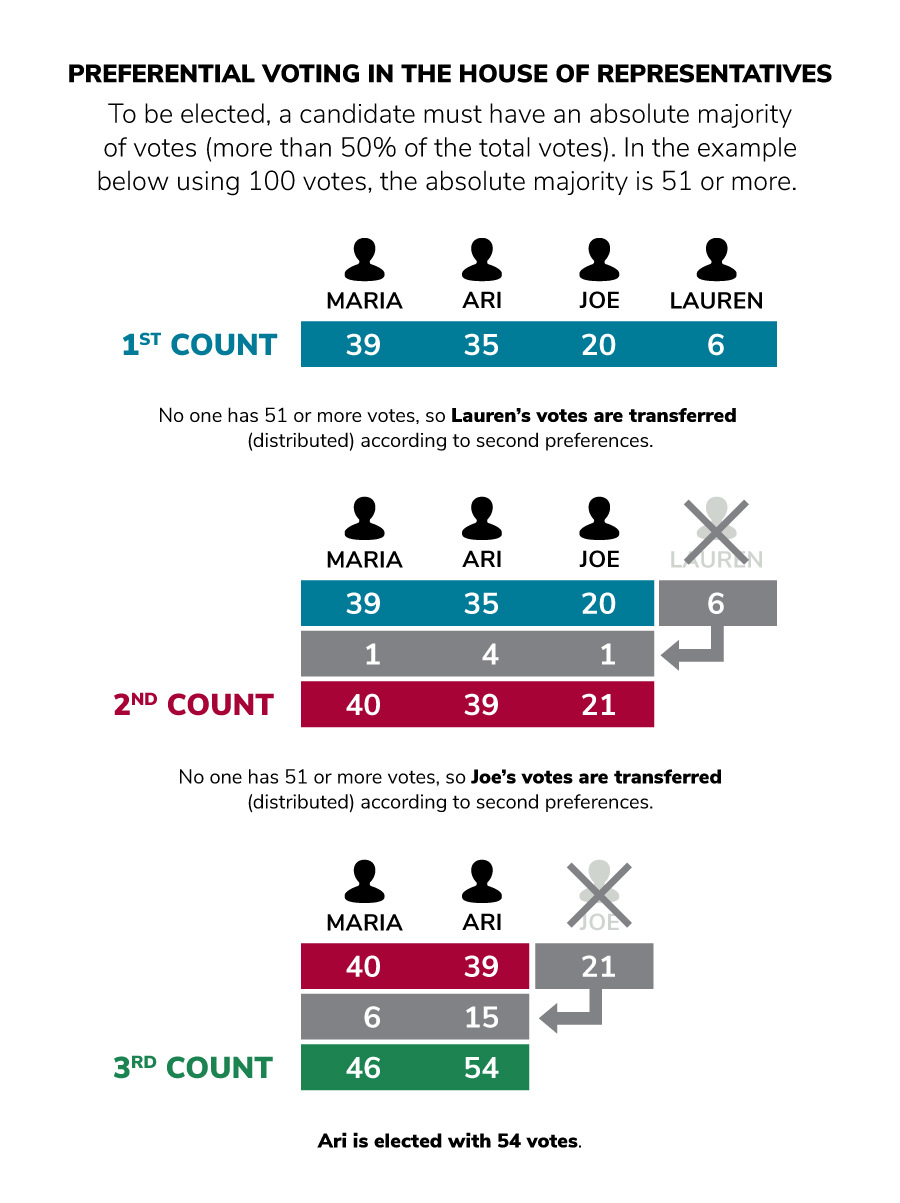Federal elections
This fact sheet explores how federal elections are used to select representatives in the Australian Parliament. It covers the process of electing senators and members of the House of Representatives.
What will I learn?
- Federal elections are used to select representatives in the Australian Parliament.
- Preferential voting is used in federal elections.
- Different methods are used to elect senators and members of the House of Representatives.
Curriculum alignment
Year 5 ACHASSK116
Year 6 ACHASSK145
Year 8 ACHCK062
What is a federal election?
Sample House of Representatives ballot paper

Australian Electoral Commission
Description
A sample House of Representatives ballot paper. It includes the words 'House of Representatives Ballot Paper, State, Electoral Division of Division Name. Number the boxes from 1 to 8 in the order of your choice'. Below are 8 boxes with 'SURNAME, Given Names, PARTY' next to each. Some boxes also have a LOGO box next to them.
Copyright information
Permission should be sought from the Australian Electoral Commission (AEC) for third-party or commercial uses of this image. To contact the AEC email: media@aec.gov.au or phone: 13 23 26.
Sample House of Representatives ballot paper

Australian Electoral Commission
Description
A sample House of Representatives ballot paper. It includes the words 'House of Representatives Ballot Paper, State, Electoral Division of Division Name. Number the boxes from 1 to 8 in the order of your choice'. Below are 8 boxes with 'SURNAME, Given Names, PARTY' next to each. Some boxes also have a LOGO box next to them.
Copyright information
Permission should be sought from the Australian Electoral Commission (AEC) for third-party or commercial uses of this image. To contact the AEC email: media@aec.gov.au or phone: 13 23 26.
A federal election is when Australians vote for people to represent them in the Senate and House of Representatives in the Australian Parliament.
Australia is a representative democracy. Australians vote to elect members of parliament to make laws and decisions on their behalf. It is compulsory for Australian citizens 18 years and older to enrol and vote. The Australian Parliament is accountable to the people of Australia. At federal elections, Australians choose people to represent their views and interests. If voters do not like the decisions or actions of their representatives, they can vote for different candidates at the next election.
Federal elections are organised and run by the Australian Electoral Commission, who make sure that elections are fair and legal. The Commonwealth Electoral Act 1918 and the Australian Constitution set out the requirements for running elections.
Electing Representatives
Preferential voting is used at federal elections. Voters fill in the ballot paper to show their order of preference for the candidates.
There is no fixed schedule for holding federal elections. Usually, Senate and House elections are held at the same time, though they don’t have to be. Section 28 of the Australian Constitution says that House of Representatives elections must be held at least every 3 years. Section 7 of the Constitution says that state senators are elected for 6-year terms. Territory senators are elected for a period of 3 years at the same time as the members of the House of Representatives.
Preferential voting in the House of Representatives

Parliamentary Education Office (peo.gov.au)
Description
To be elected, a candidate must have an absolute majority of votes (more than 50% of the total votes). In the example below using 100 votes, the absolute majority is 51 or more.
First count: Maria receives 39 votes, Ari receives 35 votes, Joe receives 20 votes, Lauren receives 6 votes. No one has 51 or more votes, so Lauren’s votes are transferred (distributed) according to second preferences.
Second count: Maria is transferred 1 vote bringing her total to 40 votes. Ari is transferred 4 votes bringing their total to 39 votes. 1 vote is transferred to Joe, bringing his total to 21 votes. No one has 51 or more votes, so Joe’s votes are transferred (distributed) according to the next preferences.
Third count: 6 votes are transferred to Maria, bringing her total to 46 votes. 15 votes are transferred to Ari bringing their total to 54 votes.
Ari is elected with 54 votes.
Copyright information
This work is licensed under a Creative Commons Attribution-NonCommercial-NoDerivs 3.0 Unported License.
You are free to share – to copy, distribute and transmit the work.
Attribution – you must attribute the work in the manner specified by the author or licensor (but not in any way that suggests that they endorse you or your use of the work).
Non-commercial – you may not use this work for commercial purposes.
No derivative works – you may not alter, transform, or build upon this work.
Waiver – any of the above conditions can be waived if you get permission from the copyright holder.
State senators are elected using a system of rotation that ensures that only half the state senators end their term every 3 years. This is why, usually, only half of the 72 state senators plus the 4 senators representing territories are selected at a time. This is known as a half-Senate election.
Members of the House of Representatives
Voters elect a representative to speak on behalf of their electorate in the House of Representatives. Currently, there are 151 electorates in Australia, each with roughly the same number of voters. Each electorate has one representative in the House, so there are 151 members.
For the House of Representatives, voters must write a number in the box beside every name on the ballot-paper: '1' for their first preference, '2' for their second preference and so on, until all the boxes are numbered.
If a candidate gets an absolute majority – more than half – of first preference votes, they are elected. If no candidate receives an absolute majority, the candidate with the least number of votes is excluded from the count. Their votes are transferred to whichever candidate voters marked as their second preference. The process of transferring votes according to preferences continues until one candidate has an absolute majority of votes and is elected.
Senators
Voters choose senators to represent their state or territory. Section 7 of the Constitution says that states must have equal representation in the Senate—this does not apply to territories. Currently, 12 senators are elected to represent each state and 2 senators are elected to represent each territory.
The counting system for the Senate is designed to elect senators in proportion to the votes in that state or territory. Because of this, a wider range of political parties and/or independents are often elected to the Senate.
Voters have a choice of voting above-the-line or below-the-line:
Sample Senate ballot paper – voting above the line

Australian Electoral Commission
Description
This image is of a sample Senate ballot paper showing how to cast a valid vote above the line. There is a printed black horizontal line through the ballot paper. There are 7 boxes with 'Party' written above the line. These boxes have been numbered 1 to 6, one box has been left blank. There are many boxes with 'Surname, Given names, party' written below the line. All the boxes below the line have been left blank.
Copyright information
Permission should be sought from the Australian Electoral Commission (AEC) for third-party or commercial uses of this image. To contact the AEC email: media@aec.gov.au or phone: 13 23 26.
- Above-the-line voting requires voters to number at least 6 boxes from 1 to 6 for their chosen parties or groups. Voters' preferences are allocated in the order that the candidates in the chosen parties or groups are listed below the line.
- Below-the-line voting requires voters to number at least 12 boxes from 1 to 12 for their chosen individual candidates.
To be elected, a candidate must gain a quota – proportion – of the state or territory votes.
The counting process for a Senate election is more complicated than the system used for the House of Representatives—it sometimes takes several weeks after an election to count all the Senate votes and finalise the result.
By-elections and casual vacancies
A by-election is an election held for a House of Representatives electorate if a member resigns, dies, or is found to be ineligible between federal elections.
A casual vacancy occurs in the Senate if a senator resigns, becomes ineligible or dies before their term has expired. They are replaced by a candidate from the same political party, chosen by the parliament or legislative assembly of that state/territory.
